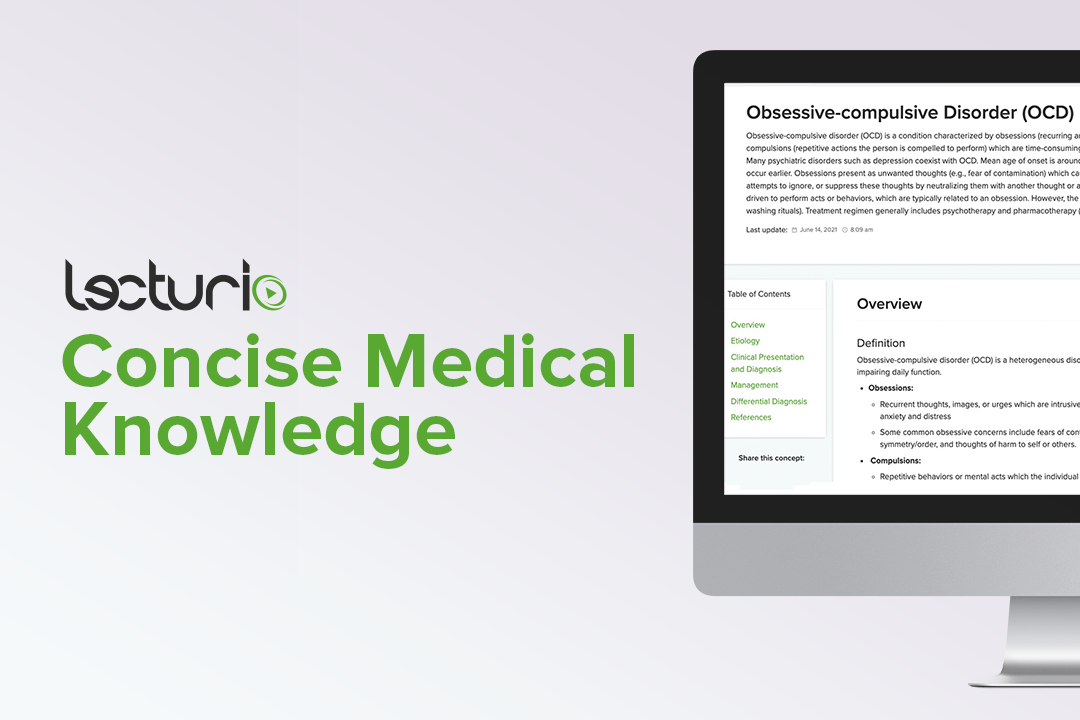Playlist
Show Playlist
Hide Playlist
OCD: Types, Assessment and Treatment
-
Slides OCD Psychiatry.pdf
-
Download Lecture Overview
00:01 Studies have shown that actually using both behavioral therapy and pharmacology together can best help the patient achieve optimal results. 00:04 Obsessions again are repetitive and persistent thoughts, images or urges, and these are not experienced as pleasurable at all. 00:14 Compulsions are rituals or mental acts that an individual feels driven to perform in an effort to neutralize their thoughts. 00:25 Urges to harm one’s self or others is extremely important to elicit in your history of the patient and if you do find that the patient, maybe while presenting with OCD type symptoms, is also having self-injurious or thoughts of hurting other people. 00:44 It’s really important that you take further action immediately to keep them and others safe. 00:50 So, we’re going to go through some examples now of obsessions and compulsions and I’d like you to take a guess at where these appropriately fit. 01:00 So what are mental acts? Well, mental acts can be compulsions. 01:09 Repeating words or numbers silently, again, are compulsions. 01:14 Repetitive behaviors are compulsions. 01:17 Counting is a compulsion. 01:20 Images of violent scenes, this would be obsessional thoughts, and urges like thinking about stabbing or hurting someone else, that’s also an obsessional thought. 01:30 How about contamination or fears of contamination? That’s again an obsession. 01:36 And what about washing, repetitive washing? That’s a compulsion. 01:41 Checking things over and over again, that’s another example of a compulsion. 01:46 So, Jane's obsessions are often handled by attempting to ignore, avoid, suppress or neutralize them with another thought or action. 01:56 Compulsions are often used to neutralize these recurrent, intrusive, and unwanted thoughts, images or urges. 02:03 Jane's aim is to reduce the distress triggered by obsessions or to prevent a feared event. 02:13 When it comes to assessing obsessions, here are the things you need to consider. 02:18 Is the obsession intrusive and repetitive? Is it thoughts and images? Are there dysfunctional beliefs? Things like an inflated sense of responsibility and the tendency to overestimate that threat. 02:34 Perfectionism and the intolerance of uncertainty or overvaluing the importance of one’s thoughts. 02:41 And is somebody avoiding people, places or things because they may trigger the obsessions? In doing your assessment, it’s important to note that compulsions are not always connected in a realistic way to the feared event, and they also are clearly excessive, so they’re really overboard. 03:02 In our example of Jane, she counts and switches lights compulsively. 03:07 This would not directly relate to preventing an intractable illness, which she is greatly afraid of. 03:13 So again, there is no realistic connection between the two. 03:17 In your assessment of compulsions, consider the following. 03:21 Are there repetitive behaviors? Things like washing, switching, checking things or mental acts like counting, repeating words and phrases. 03:31 Does the individual feel driven to perform a compulsive act in response to an obsession or according to rules that must be very rigidly applied? In compulsions, the aim is to reduce the stress triggered by obsessions or prevent a feared event. 03:48 Think about our example with Jane, she washed her hands and counted in an effort to avoid becoming ill. 03:58 And when somebody has a compulsion, they will avoid people, places or things that trigger the compulsive act. 04:09 Also note that if it is embarrassing, then a patient may not volunteer information or it may incriminate them such as thoughts of wanting to harm other people. 04:21 So when you’re doing your assessment and you’re overtly asking somebody about obsessions and compulsions, it's really important to note that they might feel embarrassed by sharing this information. 04:33 So therefore, that therapeutic alliance between the doctor and patient is extremely important. 04:37 You must have their trust in order for them to open up. 04:41 The OCD is also associated with a number of different things. 04:46 It’s associated with reduced quality of life as well as high levels of social and occupational impairment. 04:55 So when you’re doing your assessment of a patient you suspect might have OCD, what are some questions you should ask? So we could start with these. 05:04 How much time is spent obsessing or engaging in a compulsive act? How much has independence been stifled? So for example, can an individual no longer leave their home because of their obsessions and compulsions? Have they lost their jobs? Lost ability to run errands? That kind of thing. 05:25 Also, what places, people or situations are being avoided? Ask how has the family been impacted? It’s really important to note if there are imposed rules onto the family, not only the individual suffering with OCD, but are they instructing their family that certain people can and can’t visit the home. 05:45 Are they very rigid about where things are placed and put away within that home and to the point that it’s causing problems. 05:52 Ask how timely homework or occupational work is getting done? And how often does one see the physician? So, you want to make sure that you ask whether or not your patient is checking with someone about their symptoms. 06:07 There are some rating scales that can be useful in assessing OCD. 06:12 One that I’d like to review is called the YBOCS. 06:14 It’s the Yale-Brown Obsessive Compulsive Scale. 06:18 And this is the standard for measuring OCD. 06:22 It consists of a checklist of obsessions and compulsions and a scale that will actually rate and assess the severity. 06:29 And it’s really important to get a baseline and then after the patient’s undergone treatment for their OCD, to repeat the YBOCS. 06:37 In that way, you have a measurable tool to see how much their symptoms have changed. 06:42 In completing the assessment, you want to think again about obsessions which are recurrent and persistent thoughts, urges or images that are experienced at some time as unwanted and intrusive. 06:56 And they cause marked stress and anxiety. 07:00 An individual will attempt to ignore such thoughts, urges or impulses or neutralize them with compulsions. 07:08 The compulsions again are repetitive behaviors that an individual feels driven to perform in response to their obsessions. 07:18 Behaviors or mental acts are aimed at preventing or reducing anxiety or distress, although they are clearly excessive when it comes to OCD. 07:29 So what are the different types of OCD? There are specifiers that you can use. 07:34 For example, a lot of patients with OCD will also experience a tic disorder. 07:41 So you could say, with or without presence of a tic disorder as a specifier. 07:45 You also could say whether or not the patient has good or fair insight. 07:49 This is important because insight is going to be a tool that will allow the patient to follow the treatment plan and recommendations. 08:00 You can also note if there is poor insight, which is also going to affect the individual in how they think about their disorder and it will probably shift and change overtime, so it’s always important to recheck in with your patients about their insight. 08:15 And another specifier for OCD is with absent insight or delusional beliefs. 08:22 So, the individual is completely convinced that OCD beliefs are true with or without delusional beliefs. 08:33 Also note, insight refers to the patients awareness that something is wrong and this really can affect the willingness of the patient to receive treatment. 08:44 And less compliant patient may not have as good of an outcome as one who actually adheres to the treatment plan. 08:52 So what kind of treatment should you use for OCD? There are certainly medications and also talk therapy options. 08:59 When it comes to treating OCD, note that behavioral and talking therapies should never be neglected. 09:07 They can be just as effective and sometimes even more effective than pharmacology. 09:13 The medications that we often use in treating OCD include SSRI and sometimes tricyclic antidepressants. 09:21 You can refer to another lecture in the anxiety series for more details about both of these medications. 09:28 When it comes to behavioral therapy, one treatment that is very useful is exposure and response prevention. 09:36 This involves prolonged exposure to the ritual-eliciting stimulus and prevention of the relieving compulsion. 09:44 For example, the patient might touch the dirty floor without washing his/her hands when they have a significant fear of contamination. 09:53 This will be a behavioral exercise teaching the patient to sit with their anxieties after touching something a little bit dirty before washing their hands. 10:02 Relaxation techniques are also employed to help patients manage their anxiety and help so that the compulsions become less and less intrusive and demanding in the patient’s life. 10:17 Studies have shown that actually using both behavioral therapy and pharmacology together can best help the patient achieve optimal results. 10:29 That concludes our discussion of OCD, a little bit about its background, diagnosis, assessment, and treatment options. 10:37 Thank you.
About the Lecture
The lecture OCD: Types, Assessment and Treatment by Helen Farrell, MD is from the course Anxiety and Stress-Related Disorders. It contains the following chapters:
- Some Kinds of Obsessions and Compulsions
- Obsessions - Assessment
- Compulsions - Assessment
- What Are the Different Types of OCD?
- What Kind of Treatment Should You Use for OCD?
Included Quiz Questions
Which of the following would NOT be considered compulsions?
- Urges
- Counting
- Repeating numbers
- Washing
- Repetitive behaviors
Which of the following is NOT related to obsessions?
- Gaining pleasure from the thoughts
- Intrusive thoughts
- Avoidance of people, places or things that might trigger the thoughts
- Overvaluing the importance of thoughts
- Overestimating threat
What should be considered when evaluating a compulsion?
- Drive to perform acts in response to an obsession or according to rigid rules
- Repetitive thoughts or images
- Over-evaluating the importance of thoughts
- Intolerance of uncertainty
- No intentions to prevent the feared event
Which of the following is NOT associated with obsessive-compulsive disorder (OCD)?
- Ego inflation
- Reduced quality of life
- Suicidal thoughts
- Social impairment
- Occupational impairment
Which scale is used for rating obsessive-compulsive disorder (OCD)?
- Yale-Brown Obsessive-Compulsive Scale (YBOCS)
- Hare Psychopathy checklist
- Taylor Manifest Anxiety Scale
- Hamilton Anxiety Scale
- Disruptive Behaviors Disorders Rating Scale
Which among the following is a specifier for classifying the different obsessive-compulsive disorders (OCDs)?
- Tic disorder
- Ataxia
- Restless leg syndrome
- Tremor
- Dyskinesia
Which of the following is NOT a treatment option for obsessive-compulsive disorder (OCD)?
- Phenothiazines
- Exposure and response prevention
- TCAs
- Relaxation techniques
- SSRIs
Customer reviews
3,5 of 5 stars
| 5 Stars |
|
1 |
| 4 Stars |
|
0 |
| 3 Stars |
|
0 |
| 2 Stars |
|
1 |
| 1 Star |
|
0 |
I gave this rating due to the fact that the lecturer reads from the slides and often gets sidetracked from actually explaining the material. This gives the impression that there is a very poor understanding of the material being taught as it simply does not flow naturally. The slides are somewhat descriptive and that makes this series passable.
1 customer review without text
1 user review without text




